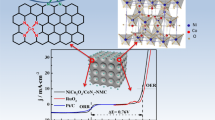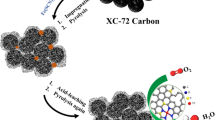Abstract
More recently, sp3 defects have been reported to show great potential for enhancing the oxygen reduction reaction (ORR) activity of metal-free carbon catalysts. However, it is still a challenge to increase the sp3 defects for achieving superior ORR activity, especially using organics as precursors by ambient-pressure pyrolysis. Herein, sp3-hybridized C and N enriched melamine–formaldehyde resin microspheres were employed for pyrolysis to increase sp3 defects in derived carbons under activation of urea. Under the synergistic effects of intrinsic characteristics of MF microspheres and the activation of sacrificial urea, the derived carbon was endowed to abundant sp3 defects and N species couple with a hierarchical porous structure. Owing to these specific features, the derived metal-free carbon catalyst showed extremely superior ORR activity, zinc-air battery performance and durability. This study provides an insight into the inheritance of sp3 carbon from the precursor to the sp3 defects in final derived carbon catalysts.
Graphical Abstract
The sp3 defects were increased by pyrolysis sp3-hybridized C and N enriched melamine–formaldehyde microspheres under the activation of urea, by which a metal-free carbon catalyst with superior ORR activity was obtained.






Similar content being viewed by others
References
Li W, Wang D, Zhang Y, Tao L, Wang T, Zou Y, Wang Y, Chen R, Wang S (2020) Adv Mater 32:1907879
Tang L, Meng X, Deng D, Bao X (2019) Adv Mater 31:e1901996
Banham D, Kishimoto T, Zhou Y, Sato T, Bai K, Ozaki JI, Imashiro Y, Ye S (2018) Sci Adv 4:eaar7180
Fu G, Wang J, Chen Y, Liu Y, Tang Y, Goodenough J, Lee JM (2018) Adv Energy Mater 8:1802263
Fu G, Wang Y, Tang Y, Zhou K, Goodenough JB, Lee J-M (2019) ACS Mater Lett 1:123–131
Shao M, Chang Q, Dodelet J-P, Chenitz R (2016) Chem Rev 116:3594–3657
Huang L, Zaman S, Tian X, Wang Z, Fang W, Xia BY (2021) Acc Chem Res 54:311–322
Xiang Z-P, Tan A-D, Fu Z-Y, Piao J-H, Liang Z-X (2020) J Energy Chem 49:323–326
Guo Z, Zhang Z, Li Z, Dou M, Wang F (2019) Nano Energy 57:108–117
Tang C, Zhang Q (2017) Adv Mater 29:1604103
Tang T, Jiang W-J, Liu X-Z, Deng J, Niu S, Wang B, Jin S-F, Zhang Q, Gu L, Hu J-S, Wan L-J (2020) J Am Chem Soc 142:7116–7127
He C, Zhang Y, Zhang Y, Zhao L, Yuan L-P, Zhang J, Ma J, Hu J-S (2020) Angew Chem Int Ed 59:4914–4919
Zhu Y, Murali S, Cai W, Li X, Suk JW, Potts JR, Ruoff RS (2010) Adv Mater 22:3906–3924
Zhang J, Jiang W-J, Niu S, Zhang H, Liu J, Li H, Huang G-F, Jiang L, Huang W-Q, Hu J-S, Hu W (2020) Adv Mater 32:1906015
Liu Z, Wang M, Luo X, Li S, Li S, Zhou Q, Xu W, Wu R (2021) Appl Surf Sci 544:148912
Yang L, Jiang S, Zhao Y, Zhu L, Chen S, Wang X, Wu Q, Ma J, Ma Y, Hu Z (2011) Angew Chem Int Ed 50:7132–7135
Wu K-H, Wang D-W, Gentle IR (2015) Carbon 81:295–304
Gong K, Du F, Xia Z, Durstock M, Dai L (2009) Science 323:760–764
Xie Q, Si W, Shen Y, Wang Z, Uyama H (2021) Nanoscale 13:16296–16306
Xie Q, Si W, Wang Z, Shu Y, Li C, Shen Y, Uyama H (2023) Chem Eng J 452:139221
Si W, Xie Q, Zhang R, Wang Z, Shen Y, Uyama H (2022) Dalton Trans 51:11363–11371
Shao W, Yan R, Zhou M, Ma L, Roth C, Ma T, Cao S, Cheng C, Yin B, Li S (2023) Electrochem Energy Rev 6:11
Li Y, Li Q, Wang H, Zhang L, Wilkinson DP, Zhang J (2019) Electrochem Energy Rev 2:518–538
Jiang Y, Yang L, Sun T, Zhao J, Lyu Z, Zhuo O, Wang X, Wu Q, Ma J, Hu Z (2015) ACS Catal 5:6707–6712
Tao L, Wang Q, Dou S, Ma Z, Huo J, Wang S, Dai L (2016) Chemical Commun 52:2764–2767
Jia Y, Zhang L, Du A, Gao G, Chen J, Yan X, Brown CL, Yao X (2016) Adv Mater 28:9532–9538
Cao Y, Liu Z, Tang Y, Huang C, Wang Z, Liu F, Wen Y, Shan B, Chen R (2021) Carbon 180:1–9
Tao L, Qiao M, Jin R, Li Y, Xiao Z, Wang Y, Zhang N, Xie C, He Q, Jiang D, Yu G, Li Y, Wang S (2019) Angew Chem Int Ed 58:1019–1024
Jia Y, Zhang L, Zhuang L, Liu H, Yan X, Wang X, Liu J, Wang J, Zheng Y, Xiao Z, Taran E, Chen J, Yang D, Zhu Z, Wang S, Dai L, Yao X (2019) Nat Catal 2:688–695
Jin H, Huang H, He Y, Feng X, Wang S, Dai L, Wang J (2015) J Am Chem Soc 137:7588–7591
Gao J, Wang Y, Wu H, Liu X, Wang L, Yu Q, Li A, Wang H, Song C, Gao Z, Peng M, Zhang M, Ma N, Wang J, Zhou W, Wang G, Yin Z, Ma D (2019) Angew Chem Int Ed 58:15089–15097
Visscher GT, Nesting DC, Badding JV, Bianconi PA (1993) Science 260:1496–1499
Hao M-g, Dun R-m, Su Y-m, Li W-m (2020) Nanoscale 12:15115–15127
Friedel B, Greulich-Weber S (2006) Small 2:859–863
Choi EY, Kim DE, Lee SY, Kim CK (2020) Carbon 166:245–255
Zhao Y, Wang X, Guo X, Cheng D, Zhou H, Saito N, Fan T (2021) Carbon 184:609–617
Lu X, Ge L, Yang P, Levin O, Kondratiev V, Qu Z, Liu L, Zhang J, An M (2021) Appl Surf Sci 562:150114
Men B, Sun Y, Li M, Hu C, Zhang M, Wang L, Tang Y, Chen Y, Wan P, Pan J (2016) ACS Appl Mater Interfaces 8:1415–1423
Wei J, Hu Y, Liang Y, Kong B, Zhang J, Song J, Bao Q, Simon GP, Jiang SP, Wang H (2015) Adv Funct Mater 25:5768–5777
Nimbalkar S, Montgomery-Walsh R, Bunnell J, Galindo SL, Cariappa BK, Gautam A, Arvizu R, Yang S, Kassegne S (2022) Carbon 196:1012–1023
Wang X, Zhao T (2016) Text Res J 87:1848–1859
Wang Q, Ji Y, Lei Y, Wang Y, Wang Y, Li Y, Wang S (2018) ACS Energy Lett 3:1183–1191
Arafat Y, Azhar MR, Zhong Y, Tadé MO, Shao Z (2021) Mater Res Bull 140:111315
Zhang X, Zhang X, Zhao S, Wang YQ, Lin X, Tian ZQ, Shen PK, Jiang SP (2021) Electrochim Acta 370:137712
Takeyasu K, Furukawa M, Shimoyama Y, Singh SK, Nakamura J (2021) Angew Chem Int Ed 60:5121–5124
Zhang J, Zhang G, Jin S, Zhou Y, Ji Q, Lan H, Liu H, Qu J (2020) Carbon 163:154–161
Miao H, Li S, Wang Z, Sun S, Kuang M, Liu Z, Yuan J (2017) Int J Hydrog Energy 42:28298–28308
Luo E, Xiao M, Ge J, Liu C, Xing W (2017) J Mater Chem A 5:21709–21714
Tang L, Xu Q, Zhang Y, Chen W, Wu M (2022) Electrochem Energy Rev 5:32–81
Funding
We all thank to the financial support of the Natural Science Basic Research Program of Shaanxi (Program No. 2022JQ-107) and the Natural Science Foundation of China (Program No. 22178284).
Author information
Authors and Affiliations
Contributions
WS and QX conducted the experiments and characterizations; ZW conceived of the presented idea, wrote the paper and supervised the findings of this work; all authors discussed the results and contributed to the final manuscript.
Corresponding authors
Ethics declarations
Conflict of interest
The authors declare no conflict of interest.
Additional information
Publisher's Note
Springer Nature remains neutral with regard to jurisdictional claims in published maps and institutional affiliations.
Supplementary Information
Below is the link to the electronic supplementary material.
Rights and permissions
Springer Nature or its licensor (e.g. a society or other partner) holds exclusive rights to this article under a publishing agreement with the author(s) or other rightsholder(s); author self-archiving of the accepted manuscript version of this article is solely governed by the terms of such publishing agreement and applicable law.
About this article
Cite this article
Si, W., Xie, Q., Shen, Y. et al. Melamine–Formaldehyde Resin Derived Carbon Catalysts with Abundant Intrinsic Defects to Afford Superior Oxygen Reduction Activity. Catal Lett 154, 1819–1827 (2024). https://doi.org/10.1007/s10562-023-04412-0
Received:
Accepted:
Published:
Issue Date:
DOI: https://doi.org/10.1007/s10562-023-04412-0




